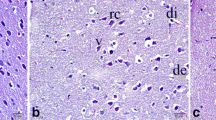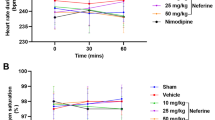Abstract
The aim of this study was to investigate the effects of β-myrcene (MYR) on oxidative and histological damage in brain tissue caused by global cerebral ischemia/reperfusion (I/R) in C57BL/J6 mice. Mice (n = 40) were equally divided into four groups: (1) sham-operated (SH), (2) global cerebral I/R, (3) MYR, and (4) MYR + I/R. The SH group was used as a control and received 0.1 % carboxymethyl cellulose (CMC) as a vehicle following a medial incision without carotid occlusion. In the I/R group, the bilateral carotid arteries were clipped for 15 min, and treated with the vehicle intraperitoneally (i.p.) for 10 days. In the MYR group, mice were given 200 mg/kg MYR dissolved in 0.1 % CMC for 10 days following a medial incision without carotid occlusion. In the MYR + I/R group, the I/R procedure was performed exactly as in the I/R group, and they were then treated with the same dose of MYR for 10 days. Cerebral I/R induced oxidative stress via an increase in thiobarbituric acid reactive substances (TBARS) formation and a decrease in the antioxidant defense systems, including glutathione (GSH), catalase, glutathione peroxidase (GPx) and superoxide dismutase (SOD). However, MYR treatment protected against the oxidative effects of I/R by inducing significant increases in GSH, GPx, and SOD and a significant decrease in the formation of TBARS. Additionally, cerebral I/R increased the incidence of histopathological damage and apoptosis in brain tissue, but these neurodegenerative effects were eliminated by MYR treatment. This study has demonstrated that MYR effectively attenuates oxidative and histological damage in the brain caused by global I/R. The beneficial effects of MYR probably contribute to its strong antioxidant and radical scavenging properties. In conclusion, MYR may be useful for the attenuation of the negative effects of global cerebral I/R and, in the future, may be a viable and safe alternative treatment for ischemic stroke in humans.




Similar content being viewed by others
References
Yasuda N, Ishii T, Oyama D, Fukuta T, Agato Y, Sato A, Shimizu K, Asai T, Asakawa T, Kan T, Yamada S, Ohizumi Y, Oku N (2014) Neuroprotective effect of nobiletin on cerebral ischemia–reperfusion injury in transient middle cerebral artery-occluded rats. Brain Res doi: 10.1016/j.brainres.2014.02.007. [Epub ahead of print]
Zhang S, Qi Y, Xu Y, Han X, Peng J, Liu K, Sun CK (2013) Protective effect of flavonoid-rich extract from Rosa laevigata Michx on cerebral ischemia–reperfusion injury through suppression of apoptosis and inflammation. Neurochem Int 63(5):522–532. doi:10.1016/j.neuint.2013.08.008
Zhan C, Yang J (2006) Protective effects of isoliquiritigenin in transient middle cerebral artery occlusion-induced focalcerebral ischemia in rats. Pharmacol Res 53(3):303–309 Epub 2006 Feb 3
Heo JH, Han SW, Lee SK (2005) Free radicals as triggers of brain edema formation after stroke. Free Radic Biol Med 39:51–70
Margaill I, Plotkine M, Lerouet D (2005) Antioxidant strategies in the treatment of stroke. Free Radic Biol Med 39:429–443
Oztanir MN, Ciftci O, Cetin A, Durak MA, Basak N, Akyuva Y (2014) The beneficial effects of 18β-glycyrrhetinic acid following oxidative and neuronal damage in brain tissue caused by global cerebral ischemia/reperfusion in a C57BL/J6 mouse model. Neurol Sci. doi:10.1007/s10072-014-1685-9
Oztanir MN, Ciftci O, Cetin A, Aladag MA (2014) Hesperidin attenuates oxidative and neuronal damage caused by global cerebral ischemia/reperfusion in a C57BL/J6 mouse model. Neurol Sci. doi:10.1007/s10072-014-1725-5
Aras M, Altaş M, Meydan S, Nacar E, Karcıoğlu M, Ulutaş KT, Serarslan Y (2014) Effects of ebselen on ischemia/reperfusion injury in rat brain. Int J Neurosci. doi:10.3109/00207454.2013.879581
Cesta MF, Hard GC, Boyce JT, Ryan MJ, Chan PC, Sills RC (2013) Complex histopathologic response in rat kidney to oral β-myrcene: an unusual dose-related nephrosis and low-dose alpha2u-globulin nephropathy. Toxicol Pathol 41(8):1068–1077. doi:10.1177/0192623313482057
Bonamin F, Moraes TM, Dos Santos RC, Kushima H, Faria FM, Silva MA, Junior IV, Nogueira L, Bauab TM, Souza Brito AR, da Rocha LR, Hiruma-Lima CA (2014) The effect of a minor constituent of essential oil from Citrus aurantium: the role of β-myrcene in preventing peptic ulcer disease. Chem Biol Interact 212C:11–19. doi:10.1016/j.cbi.2014.01.009
Ciftci O, Tanyildizi S, Godekmerdan A (2011) Curcumin, myrecen and cineol modulate the percentage of lymphocyte subsets altered by 2,3,7, 8-tetracholorodibenzo-p-dioxins (TCDD) in rats. Hum Exp Toxicol 30(12):1986–1994. doi:10.1177/0960327111404909
Ciftci O, Ozdemir I, Tanyildizi S, Yildiz S, Oguzturk H (2011) Antioxidative effects of curcumin, β-myrcene and 1,8-cineole against 2,3,7,8-tetrachlorodibenzo-p-dioxin-induced oxidative stress in rats liver. Toxicol Ind Health 27(5):447–453. doi:10.1177/0748233710388452
Yonekura I, Kawahara N, Nakatomi H, Furuya K, Kirino T (2004) A model of global cerebral ischemia in C57 BL/6 mice. J Cereb Blood Flow Metab 24:151–158
Ciftci O, Ozdemir I, Aydin M (2011) Beytur A (2012) Beneficial effects of chrysin on the reproductive system of adult male rats. Andrologia 44(3):181–186. doi:10.1111/j.1439-0272.2010.01127.x
Kamisli S, Ciftci O, Kaya K, Cetin A, Kamisli O, Ozcan C (2013) Hesperidin protects brain and sciatic nerve tissues against cisplatin-induced oxidative, histological and electromyographical side effects in rats. Toxicol Ind Health. doi:10.1177/0748233713483192
Wang B, Wu N, Liang F, Zhang S, Ni W, Cao Y, Xia D, Xi H (2014) 7,8-Dihydroxyflavone, a small-molecule tropomyosin-related kinase B (TrkB) agonist, attenuates cerebral ischemia and reperfusion injury in rats. J Mol Histol 45(2):129–140. doi:10.1007/s10735-013-9539-y
Ciftci O, Ozdemir I (2011) Protective effects of quercetin and chrysin against 2,3,7,8-tetrachlorodibenzo-p-dioxin (TCDD) induced oxidative stress, body wasting and altered cytokine productions in rats. Immunopharmacol Immunotoxicol 33(3):504–508. doi:10.3109/08923973.2010.543686
Yang Y, Liu P, Chen L, Liu Z, Zhang H, Wang J, Sun X, Zhong W, Wang N, Tian K, Zhao J (2013) Therapeutic effect of Ginkgo biloba polysaccharide in rats with focal cerebral ischemia/reperfusion (I/R) injury. Carbohydr Polym 98(2):1383–1388. doi:10.1016/j.carbpol.2013.07.045 Epub 2013 Jul 29
Malik ZA, Singh M, Sharma PL (2011) Neuroprotective effect of Momordica charantia in global cerebral ischemia and reperfusion induced neuronaldamage in diabetic mice. J Ethnopharmacol. 133(2):729–734. doi:10.1016/j.jep.2010.10.061
Liu B, Yin G, Ding L, Ma Y (2008) Research on the influence of diammonium glycyrrhizinate on the expression of NF-kappaB and neuron apoptosis after spinal cord ischemia–reperfusion injury in rats. Zhongguo Xiu Fu Chong Jian Wai Ke Za Zhi 22:1466–1469
Wang JJ, Cui P (2013) Neohesperidin attenuates cerebral ischemia–reperfusion injury via inhibiting the apoptotic pathway and activating the Akt/Nrf2/HO-1 pathway. J Asian Nat Prod Res 15:1023–1037
Gaur V, Kumar A (2010) Hesperidin pre-treatment attenuates NO-mediated cerebral ischemic reperfusion injury and memory dysfunction. Pharmacol Rep 62(4):635–648
Acknowledgments
We acknowledge the support of IUBAP (Scientific Research Fund of Inonu University) under Grant 2013/205.
Conflict of interest
The authors have declared no conflict of interest.
Author information
Authors and Affiliations
Corresponding author
Rights and permissions
About this article
Cite this article
Ciftci, O., Oztanir, M.N. & Cetin, A. Neuroprotective Effects of β-Myrcene Following Global Cerebral Ischemia/Reperfusion-Mediated Oxidative and Neuronal Damage in a C57BL/J6 Mouse. Neurochem Res 39, 1717–1723 (2014). https://doi.org/10.1007/s11064-014-1365-4
Received:
Revised:
Accepted:
Published:
Issue Date:
DOI: https://doi.org/10.1007/s11064-014-1365-4




